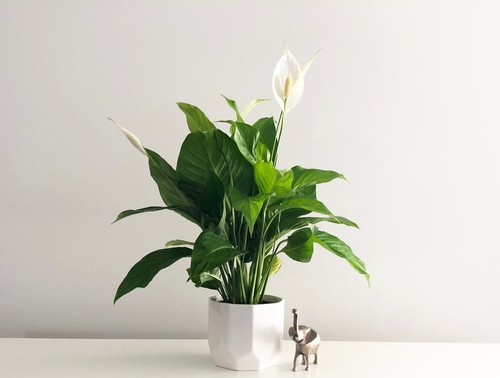Peace lilies are a popular choice for indoor plants due to their attractive foliage and ease of care. However, if you notice your peace lily flowers turning yellow or brown, it could be a sign of an underlying issue. Understanding the common factors that cause peace lily flowers to turn yellow or brown can help you address the problem and keep your plant healthy.
One of the most common reasons for yellowing or browning of peace lily flowers is overwatering or underwatering. Peace lilies prefer moist soil, but too much or too little water can cause stress to the plant and lead to discoloration.
Other factors, such as incorrect lighting, improper nutrition, pests, or diseases, can also contribute to the problem. Proper care and maintenance of peace lilies can help prevent these issues and keep your plant looking its best.
Key Takeaways on Yellow and Brown Peace Lily Flowers
- Proper watering is crucial for a healthy peace lily, as overwatering or underwatering can cause yellowing or browning of the flowers.
- Understanding common factors such as lighting, nutrition, pests, and diseases can help prevent problems with peace lily flowers.
- Regular care and maintenance, including repotting, fertilization, and pruning, can help keep your peace lily healthy and blooming.
More posts in this category:
Understanding Peace Lily
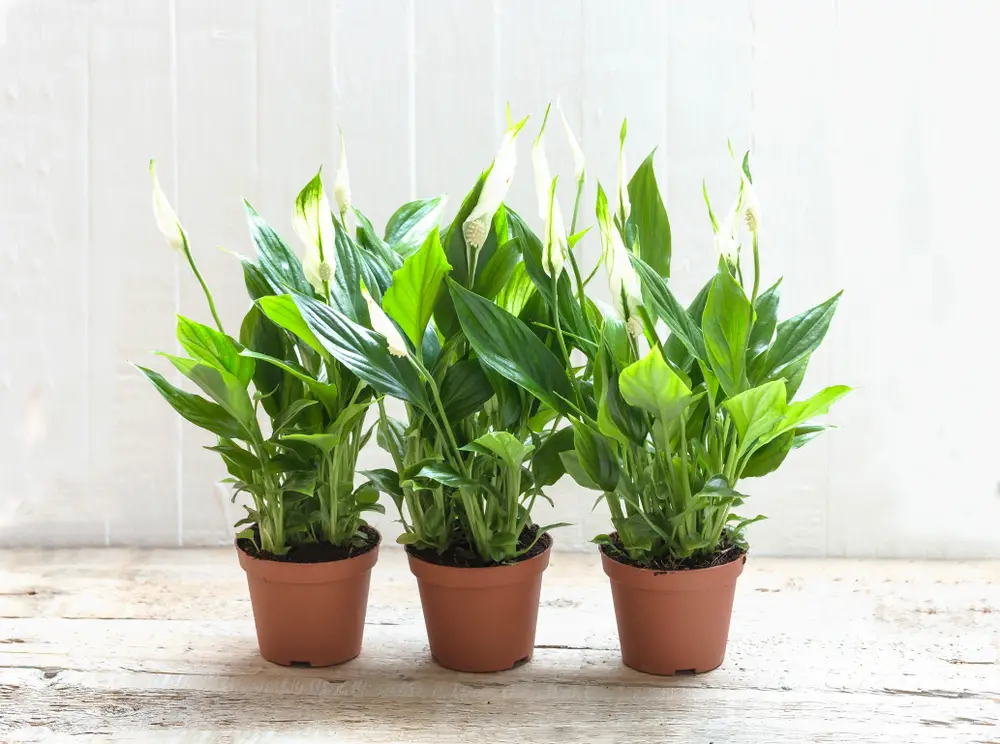
Peace lilies (Spathiphyllum wallisii) are a popular choice for houseplants due to their ease of care and attractive foliage. These tropical plants are native to the rainforests of Central and South America, where they grow in the understory beneath the canopy of larger trees.
They are known for their dark green leaves and distinctive white flowers, which are actually a modified leaf called a spathe that surrounds the true flowers.
As indoor plants, peace lilies are valued for their ability to purify the air by removing toxins such as formaldehyde, benzene, and trichloroethylene. They are also relatively low maintenance, requiring only moderate light and occasional watering.
However, like all plants, peace lilies can experience problems such as yellowing or browning leaves, which can be a sign of stress or disease.
To keep peace lilies healthy, it is important to provide them with the proper growing conditions. This includes placing them in a location with bright, indirect light and keeping the soil consistently moist but not waterlogged. Peace lilies are sensitive to both overwatering and underwatering, so it is important to find the right balance.
Additionally, peace lilies benefit from occasional fertilization with a balanced houseplant fertilizer. This can help promote healthy growth and prevent nutrient deficiencies that can lead to yellowing or browning leaves. Repotting every few years can also help refresh the soil and give the plant room to grow.
Common Factors for Yellowing and Browning
Yellowing and browning are common issues that peace lily owners may encounter. Here are some factors that can contribute to these problems:
1. Age
As peace lilies age, their leaves may turn yellow and brown. This is a natural part of the plant’s life cycle, and it is nothing to worry about. Simply remove the affected leaves to keep the plant looking its best.
2. Watering
Overwatering and underwatering can both cause peace lily leaves to turn yellow and brown. Peace lilies prefer to be kept moist but not soaking wet. It is essential to establish a consistent watering schedule and ensure proper drainage to prevent water from sitting in the pot.
3. Light

‘Peace lilies thrive in indirect light and can suffer if exposed to too much or too little light. Direct sunlight can scorch their leaves, while low light can cause them to yellow and brown. Find a spot that provides filtered light for the plant to thrive.
4. Flowers
As peace lily flowers age, they may turn brown and die. This is a natural part of the plant’s life cycle and is nothing to worry about. Simply remove the dead flowers to keep the plant looking its best.
5. Tap Water
Peace lilies are sensitive to chlorine and other chemicals found in tap water, which can cause their leaves to yellow and brown. Consider using filtered or distilled water to prevent this issue.
6. Stress
Stress can cause peace lilies to yellow and brown. This can be caused by a variety of factors, including drafts, temperature changes, and humidity levels. Keep the plant in a stable environment to prevent stress.
7. Nutrient Deficiency
A lack of nutrients can cause peace lilies to yellow and brown. Ensure the plant is receiving the proper amount of nutrients by fertilizing it every few months.
Proper Care for Peace Lily
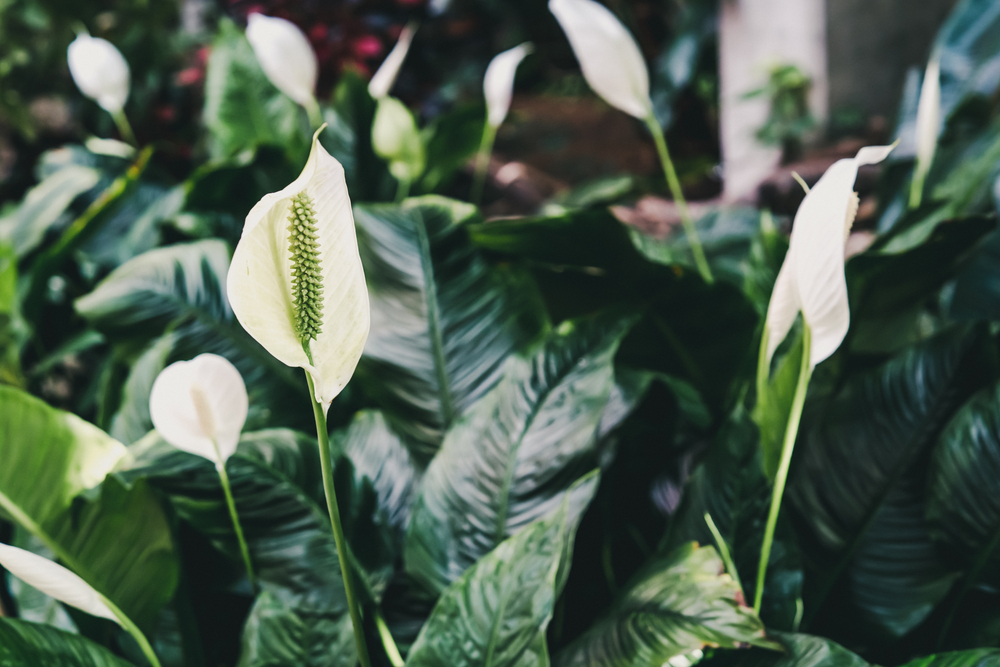
Peace lilies are a popular houseplant due to their ease of care and beautiful, vibrant flowers. However, improper care can lead to yellowing and browning of the leaves and flowers. Proper care for peace lilies is essential to keep them healthy and thriving.
Watering
Peace lilies prefer moist soil, but overwatering can cause the roots to rot. Watering once a week is usually sufficient, but the frequency may vary depending on the environment and the size of the plant.
It is best to check the soil’s moisture level by sticking a finger about an inch deep into the soil. If it feels dry, it’s time to water. Peace lilies prefer filtered water or distilled water, as they are sensitive to chemicals found in tap water. Bottom watering can also be an effective way to water peace lilies.
Temperature and Humidity
Peace lilies prefer warm and humid environments, with temperatures between 65°F and 75°F degrees during the day and about 10° cooler at night. They are sensitive to low temperatures and drafts, so keep them away from windows and doors. Peace lilies also benefit from occasional misting to increase humidity levels.
Light and Soil
Peace lilies prefer bright, indirect light, but direct sunlight can scorch their leaves. They can also tolerate low light conditions, making them a great choice for indoor spaces. Peace lilies prefer well-draining soil that is rich in organic matter. It is important to repot peace lilies every year or two to ensure they have enough space to grow.
Preventing Yellow and Brown Leaves
Yellow and brown leaves are a sign of stress in peace lilies. To prevent yellowing and browning, it is essential to provide proper care.
This includes maintaining a consistent watering schedule, using filtered or distilled water, providing adequate humidity levels, and avoiding direct sunlight and low temperatures. It is also important to remove any yellow or brown leaves promptly to prevent the spread of disease.
Dealing with Pests and Diseases
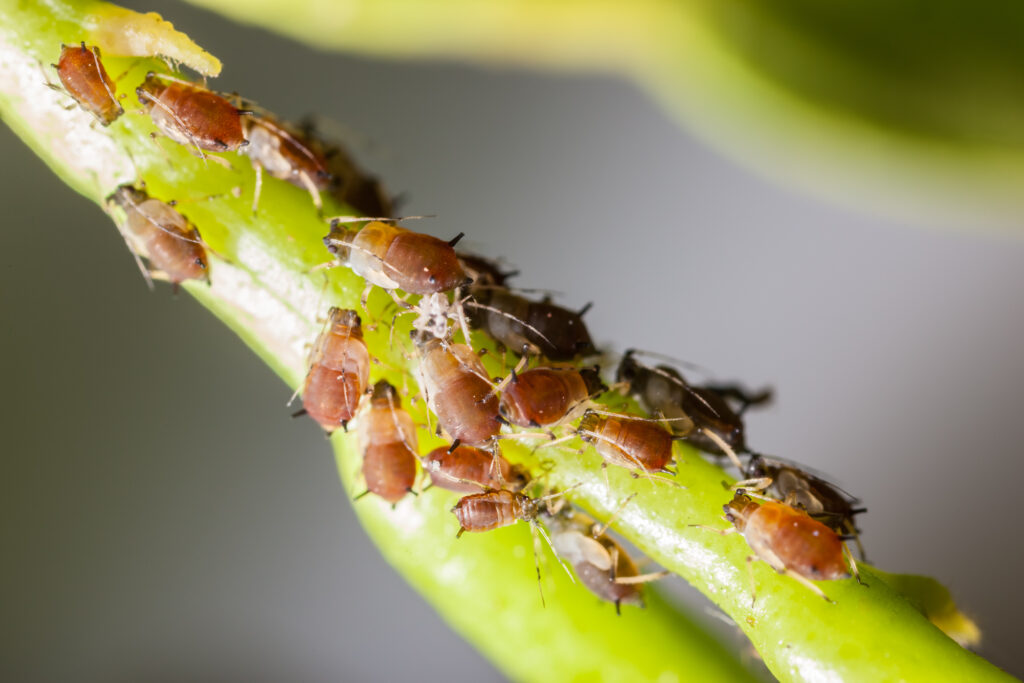
Peace lilies are not immune to pests and diseases, and they can be affected by a range of issues. Here are some common pests and diseases that can affect peace lilies and how to deal with them.
Pests
1. Thrips
Thrips are tiny insects that can cause damage to peace lilies by sucking the sap from the leaves. This can result in the leaves turning yellow or brown. To deal with thrips, use an insecticidal soap spray on the plant.
This should be sprayed directly onto the leaves and stems of the plant. Repeat this process every few days until the thrips have been eliminated.
2. Mealybugs
Mealybugs are another common pest that can affect peace lilies. They are small, white, and fluffy insects that can be found on the leaves and stems of the plant. To deal with mealybugs, use an insecticidal soap spray on the plant.
This should be sprayed directly onto the leaves and stems of the plant. Repeat this process every few days until the mealybugs have been eliminated.
3. Aphids
Aphids are small, green insects that can be found on the leaves and stems of peace lilies. They can cause damage to the plant by sucking the sap from the leaves. To deal with aphids, use an insecticidal soap spray on the plant.
This should be sprayed directly onto the leaves and stems of the plant. Repeat this process every few days until the aphids have been eliminated.
4. Spider Mites
Spider mites are tiny insects that can cause damage to peace lilies by sucking the sap from the leaves. This can result in the leaves turning yellow or brown.
To deal with spider mites, use an insecticidal soap spray on the plant. This should be sprayed directly onto the leaves and stems of the plant. Repeat this process every few days until the spider mites have been eliminated.
Diseases
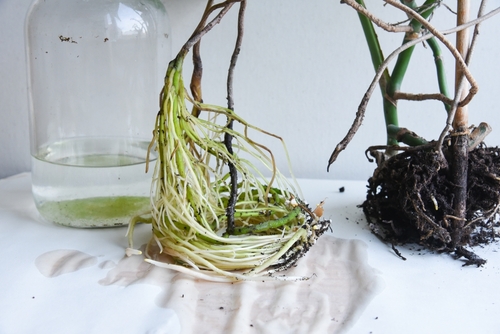
1. Root Rot
Root rot is a common disease that can affect peace lilies. It is caused by overwatering the plant, which can lead to the roots becoming waterlogged. This can result in the plant becoming weak and the leaves turning yellow or brown.
To deal with root rot, allow the soil to dry out completely before watering the plant again. If the roots have already become waterlogged, remove the plant from the pot and trim away any damaged roots. Repot the plant in fresh soil and a new pot.
2. Viral Mosaic Disease
Viral mosaic disease can cause yellow or brown spots to appear on the leaves of peace lilies. It is caused by a virus and can be difficult to treat. To deal with viral mosaic disease, remove any infected leaves from the plant and dispose of them. Keep the plant away from other plants to prevent the virus from spreading.
Repotting and Transplanting
Peace lilies need to be repotted every two to three years, or when the roots have filled the pot. Repotting helps to provide fresh soil, nutrients, and space for the plant to grow.
Before repotting, it is important to water the plant thoroughly the day before to reduce stress and make the soil easier to work with. To repot, carefully remove the plant from its current pot and gently separate the roots. If the roots are tightly packed, it may be necessary to cut them apart with a clean, sharp knife.
When selecting a new pot, choose one that is only slightly larger than the current pot to prevent overwatering. Make sure the pot has drainage holes to prevent water from sitting in the bottom and causing root rot.
Fill the new pot with fresh, well-draining potting soil and place the plant in the center. Backfill the soil around the roots, pressing down gently to ensure the plant is secure. Water the plant thoroughly and allow the excess water to drain out of the bottom of the pot.
After repotting, the plant may experience transplant shock, which can cause yellowing or drooping leaves. To minimize shock, keep the plant in a shaded area for a few days and avoid fertilizing for at least a month.
Nutrition and Fertilization

Peace lilies require proper nutrition to thrive and produce healthy leaves and flowers. Fertilizing the plant every two to three months is recommended to ensure that it receives the necessary nutrients.
When choosing a fertilizer for peace lilies, it is best to use an evenly balanced fertilizer such as 10-10-10 NPK or one that is slightly higher in nitrogen. NPK refers to the ratio of nitrogen, phosphorus, and potassium in the fertilizer mix.
Nitrogen is essential for leaf growth, while phosphorus is necessary for flower and root development. Potassium helps the plant to resist disease and stress.
Over-fertilizing can cause damage to the plant, so it is important to follow the manufacturer’s instructions carefully. Applying too much fertilizer can lead to nutrient burn, which is characterized by brown or yellow leaf tips and edges.
In addition to using a balanced fertilizer, peace lilies may also benefit from occasional applications of micronutrients such as iron and magnesium. These micronutrients can be applied using a foliar spray or added to the soil.
Nutrient deficiencies can also cause yellowing and browning of peace lily leaves. If the plant is not receiving enough nitrogen, the leaves will turn yellow and may drop off. A lack of magnesium can cause yellowing between the veins of the leaves, while a deficiency in iron can cause the leaves to turn yellow and brown.
It is important to identify the specific nutrient deficiency before applying any fertilizers or micronutrients. A soil test can help to determine which nutrients are lacking in the soil. Once the deficiency is identified, the appropriate fertilizer or micronutrient can be applied to correct the problem.
Pruning and Maintenance
Pruning and maintenance are essential for the health and longevity of a peace lily. Regular pruning helps to keep the plant looking neat and tidy, while also promoting new growth. When pruning, it is important to use clean pruning shears to avoid spreading any diseases or fungal infections.
As peace lilies age, their leaves may turn yellow or brown. This is a natural part of the plant’s life cycle, and it is nothing to be alarmed about. However, if the plant is wilting or showing signs of distress, it may be time to take action.
To recover a peace lily that is wilting or showing signs of distress, first, identify the cause of the problem. If the soil is dry, water the plant thoroughly. If the plant is root-bound, repot it into a larger container. If the plant is suffering from a fungal infection, treat it with a fungicide solution.
Regular maintenance is also important for the health of a peace lily. This includes keeping the plant in a well-lit area, away from direct sunlight, and ensuring that the soil is kept moist but not waterlogged. Fertilize the plant every two to three months with a balanced fertilizer to promote healthy growth.
Peace Lily Blooming
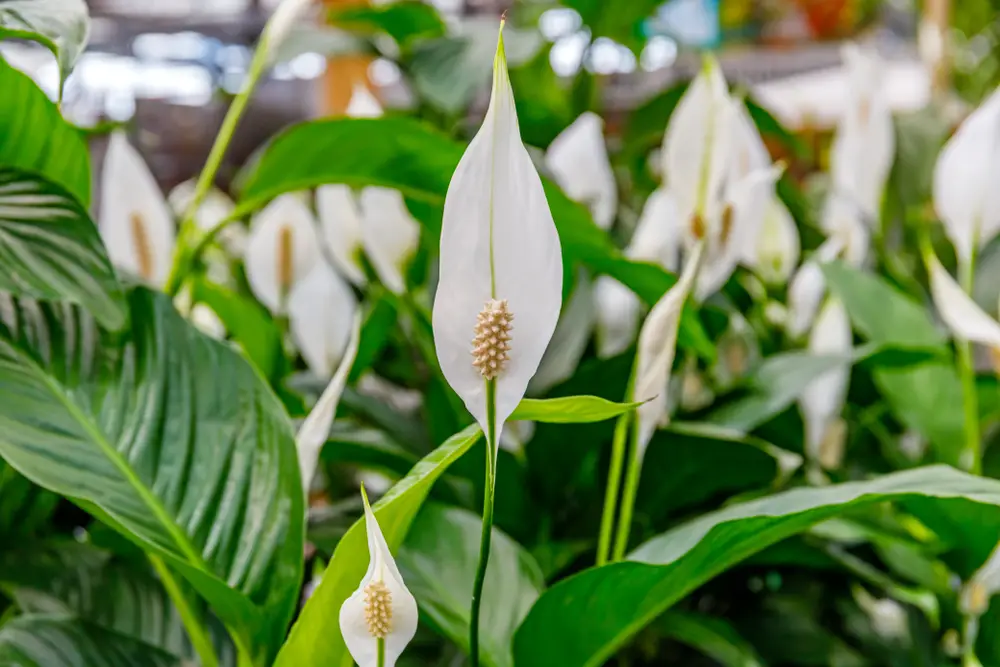
Peace lilies are known for their beautiful white flowers that can last for weeks. However, sometimes the flowers can turn yellow or brown, which can be a cause for concern for plant owners. Understanding the blooming process of peace lilies can help identify the reasons behind the discoloration of the flowers.
Peace lily flowers are actually made up of two parts: the spadix and the spathe. The spadix is the spike in the center of the flower that contains both male and female reproductive organs. The spathe is the white or green leaf-like structure that surrounds the spadix, and it is responsible for attracting pollinators to the flower.
The blooming process of peace lilies is triggered by the hormone gibberellic acid, which is produced in the plant’s roots and transported to the flower. When the hormone reaches the spadix, it stimulates the development of male and female flowers, which eventually grow into the beautiful white flowers that peace lilies are known for.
While peace lilies can bloom multiple times throughout the year, the flowers typically last for two to three weeks before fading. After the flowers have faded, the spathe will eventually turn green and start to photosynthesize, providing energy for the plant.
If peace lily flowers turn yellow or brown before they have had a chance to fully bloom, it may be due to a lack of gibberellic acid in the plant. This can be caused by a variety of factors, including poor soil quality, lack of nutrients, or insufficient light.
Ensuring that the plant receives adequate nutrients, water, and light can help promote healthy blooming and prevent discoloration of the flowers.
Conclusion
Yellow and brown peace lily flowers are a common problem that can be caused by a variety of factors, including overwatering, underwatering, direct sunlight, and poor soil quality.
To prevent yellow and brown peace lily flowers, it is important to provide proper care and maintenance for the plant. This includes watering the plant regularly, but not overwatering it, providing it with indirect or dappled sunlight, and ensuring that it is planted in well-draining soil.
If yellow or brown flowers do appear, there are several steps that can be taken to remedy the issue. These include removing any dead or dying flowers, adjusting the plant’s watering and lighting conditions, and fertilizing the plant with a high-quality fertilizer.
Overall, peace lilies are relatively easy to care for and can thrive in a variety of environments. With proper care and attention, it is possible to prevent yellow and brown flowers and keep peace lilies looking healthy and vibrant.
Frequently Asked Questions
Why is my peace lily flower turning brown?
Peace lily flowers can turn brown due to various reasons such as overwatering, underwatering, exposure to direct sunlight, or lack of humidity. If your peace lily flower is turning brown, you should check the watering schedule and adjust it accordingly.
Also, make sure to keep the plant in a shaded area and maintain the humidity level by misting the leaves regularly.
Why are my lily buds turning brown?
Lily buds can turn brown due to various reasons such as overwatering, underwatering, or exposure to direct sunlight. If your lily buds are turning brown, you should check the watering schedule and adjust it accordingly. Also, make sure to keep the plant in a shaded area and avoid exposing it to direct sunlight.
How long do peace lily flowers last?
Peace lily flowers can last for a few weeks to a few months depending on the care and maintenance. However, the flowers will eventually wilt and die. Once the flowers have wilted, you can remove them to promote new growth.
Peace lily leaves turning brown at tips?
Peace lily leaves can turn brown at the tips due to various reasons such as overfertilization, underwatering, or exposure to direct sunlight. If your peace lily leaves are turning brown at the tips, you should check the fertilization schedule and adjust it accordingly.
Also, make sure to keep the plant in a shaded area and maintain the watering schedule.
Why are the tips of my peace lily turning yellow and brown?
The tips of peace lily can turn yellow and brown due to various reasons such as overfertilization, underwatering, or exposure to direct sunlight. If the tips of your peace lily are turning yellow and brown, you should check the fertilization schedule and adjust it accordingly.
Also, make sure to keep the plant in a shaded area and maintain the watering schedule.
Should you cut yellow and brown leaves off peace lily?
If your peace lily leaves are turning yellow and brown, you can remove them to promote new growth. However, make sure to cut the leaves close to the base of the plant to avoid damaging the healthy parts. Also, make sure to maintain the watering schedule and avoid overwatering or underwatering the plant.

Hey, I’m Lisa and I’ve been an avid gardener for over 30 years. I love writing, talking and living in the garden! Feel free to connect with me on my socials below

